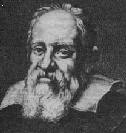
Galileo Galilei was born on February 15, 1564 in the city of Pisa. He was the eldest of three sons out of a total of seven children under their father Vincenzo Galilei. Vincenzo was a cloth merchant in the city of Pisa, and an accomplished musician also a mathematician, but he still was not a successful man.
Up to the age of eleven, Galileo was educated by his father at home, studying Latin and Greek. At the age of twelve, he was sent to the Jesuit Monastary at Vallombrosa, near Florence, where he studied the subjects of Latin, Greek, religion and music. Galileo's father wanted him to be a cloth merchant in Florence, but Galileo soon excelled way ahead of the other students to be a very talented musician, artist, poet, writer and an outstanding with model making of things related to the sciences.
In 1581, Galileo published the "Dialogue on Ancient and Modern Music." In this Dialogue, he says,"It appears that they who in proof of any assertion rely simply on the weight of an authority without adducing any argument in support of it, act very absurdly. I, on the contrary, wish to be allowed freely to question and freely to answer without any sort of adulation, as well becomes those who are sincerely in search of truth." Galileo uses this saying as a motto throughout his life.
Also in 1581 Galileo entered the University of Pisa. Here he made his very first discovery at the age of eighteen, in the form of the pendulum by experimenting with a bullet and some string. In school, Galileo was not content to learn what was said, but independently discussed its meaning. He later became very interested in mathematics during his second year at the University. Galileo became aquainted with the mathematics tutor, Ostillio Ricci, and excelled quickly in the subject.
Galileo's father could no longer pay for his education, so he went back to Florence to live with his family, but continued to study with Ostillio Ricci. Galileo moved on to study Archimede's work of combining physics and mathematics, which led to Galileo becoming the founder of modern physics.
In 1586, Galileo invented the hydrostatic balance. Then, in 1588 he became the porfessor of mathematics at the University of Pisa. In 1591, Galileo's father, Vincenzo, died leaving Galileo as the head of the family. In 1599, Galileo entered into a relationship with Marina Gamba. They later had three children, two daughters and a son.
Later Galileo formed an experiment with two balls of unequal weight, yet they fell at te same time. His expriment proved the Law of Falling Objects. In 1606, he invented the thermoscope, a primitive thermometer. One year later, he develops the first three-power telescope. He used it to observe the moon, stars and planets.
In January of 1610, Galileo observed Jupiter and found that he saw four satillites. Then, in July of the same year, Galileowas appointed Chief Mathematician of the University of Pisa and
Philosopher and Mathematician to the Grand Duke of Tuscany for life. A few months later, he moved from Padua to Florence. In 1611, Galileo discovered and composed the Law of Floating Objects. One year later, he wrote his first letter on the ever popular
sunspots.
Also in 1610, Galileo also got the idea of the motion of Earth was to rotate around the sun. This came to be known as his Copernican Theory. From here on, Galileo argued his views against the people and the church.
The church did not like these views, so they went through many investigations by the Inquisition. On January 8 of
1642, Galileo died in Arcetri.
Links
More on the life of Galileo
Galileo's math career
Yet more Galileo info
Links to Galileo info
Yet again more Galileo info
Surprise!! More info!!
Back to main page